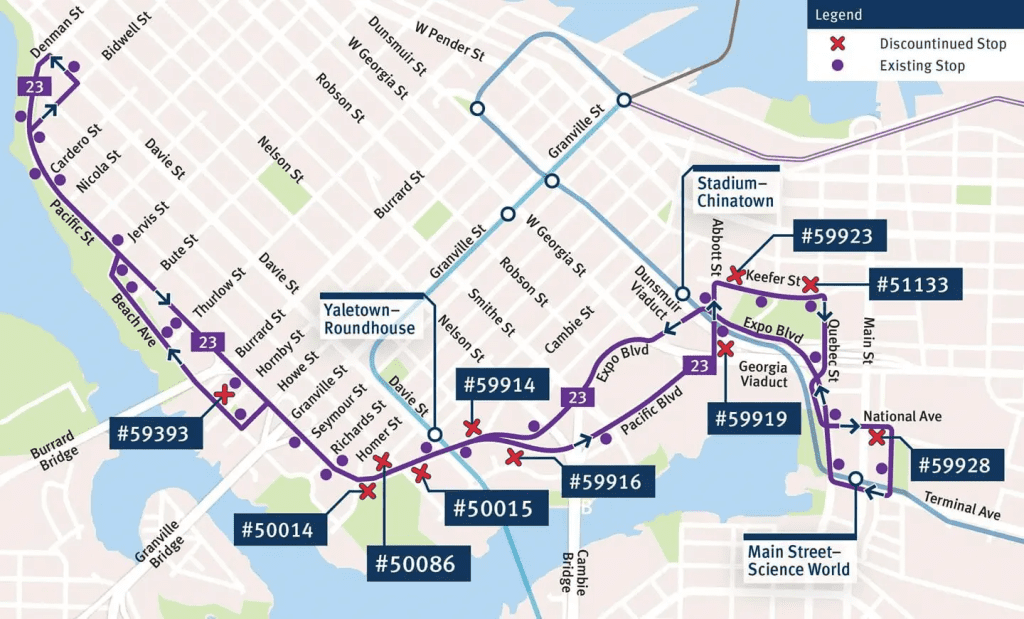Your cart is currently empty!
Big bus on the 23 and dozens of frequency boosts: Highlights of the Spring service changes
By Will Dawson and Denis Agar
TransLink has just put into effect new service changes this past Monday. The majority of the changes are housekeeping measures to respond to changes in demand, temporarily closing or truncating routes that serve much lower numbers of people in the summer months, such as some of the routes serving university campuses, and adding service on those which will see much higher demand in summer compared to the winter, such as routes serving beaches or outdoor destinations. (If you don’t know about the summer buses to beachy utopias like the 150 or the 179, you’re missing out).
The service changes contain a number of interesting details, however, that point to an evolution of our bus network here in Metro Vancouver in the longer term, including previews of some of the service changes that might follow from the new 2025 Investment Plan.

Photo of the new 40-foot 23 by Gale
Crowding Relief for Yaletown and the West End
The most standout permanent change is the upgrading of route 23 in downtown Vancouver in the West End from the small “community shuttle” minibuses to conventional 40-foot buses. The 23 has long faced chronic problems with overcrowding, unreliable scheduling, and slow speeds. The route serves some of the densest parts of the city along the shores of False Creek and English Bay and connects to major destinations such as Main Street-Science World Station, Rogers Arena, BC Place Stadium, and the beaches along English Bay, in the heavily-congested heart of downtown Vancouver.
Community shuttles cost about 2/3rd as much to operate as a 40-foot standard bus, but only have about 1/3rd the carrying capacity, so they’re mainly suited for locations with very low demand. They’ve proven woefully inadequate for the 23, with the bus seeing some of the highest rates of overcrowding on the network, frequent pass-ups, and very frequent bunching.
To address the higher cost of operating 40-foot buses, TransLink will be running the 23 less frequently, going from 7 minute frequency in peak times to 10 minutes. This reflects the constrained budget that TransLink still has to work under. [One of the main reasons Movement exists is to push for more funding for transit, so that high frequency service is widespread, as opposed to being a luxury].
Ultimately though, this change will make the experience of actually using the bus more predictable and less unpleasant, so we expect ridership on the 23 to get a big bump, drawing riders away from the 6 on Davie, which is infamously the slowest route in the region. Downtown Vancouver is going to continue to get denser in the future, so we may even see overcrowding come back to the 23 as demand grows.
Another reason the 23 may grow is due to a slight reduction in the number of bus stops on the route. It may seem paradoxical, but routes with fewer stops tend to be more popular as they offer a more competitive travel time.

TransLink’s map of the stops on the 23 that will be removed.
Frequency Improvements across the region
Key improvements are being targeted towards routes that experience severe overcrowding, particularly in Vancouver and in Surrey. Some of the highlights include:
- The 49, a perennially overcrowded route, will see targeted frequency boosts throughout the weekday and on Saturdays
- The 99 B-Line is back to 3 minute frequency in the morning peak, restoring service to pre-COVID levels. Some say 3 minutes (20 buses/hour) is the theoretical maximum frequency, where the schedule starts to disintegrate under the weight of so many buses and riders. Whether that’s true or not, we can all agree that rapid transit is long overdue on this corridor.
- Two routes are going to have some new “short-turn” trips, where the bus only serves the busiest half of the route. These will be on the 116 serving industrial areas in South Burnaby and the 373 serving residential areas in North Surrey. Both will see stunningly high frequencies for low density neighbourhoods, reflecting the boundless demand that exists in our region. Read more on the Service Changes page.
- The 130 and 222, both serving Willingdon and the Second Narrows bridge, are getting frequency boosts to address crowding.
- Over 15 routes in Surrey are getting frequency boosts at certain times to address the phenomenal overcrowding that the city has been experiencing.
- Maple Ridge and Pitt Meadows’ community shuttle routes have been stuck with practically unusable schedules for years. But finally some investment. Midday service on the 719 and 722 goes from 80 minute frequency to 40 minutes. Saturday night service is down from a whopping 120 minutes to a still-difficult 45 minutes. These routes as well as the 743 and 744 are getting Sunday and Holiday service for the first time ever! That’s right, entire neighbourhoods did not have bus service on Sundays until this week.
We need more buses
It feels good to get more service, right? Imagine the tens or hundreds of thousands of people who will be affected by all these changes. This is what happens when we expand transit.
We know that new funding has been committed for a 5% increase in service between now and 2027, but we’re still committed to pushing for much greater increases. TransLink’s own plan calls for 10% increases each year for 10 years, which would go a long way towards fighting congestion and ensuring access to mobility for all. To make that happen, we’ll need the funding to come from somewhere, and Movement will be working in the coming months to host discussions on where to find that funding.
Please stay connected by joining our e-mail list, and consider donating to boost our reach!